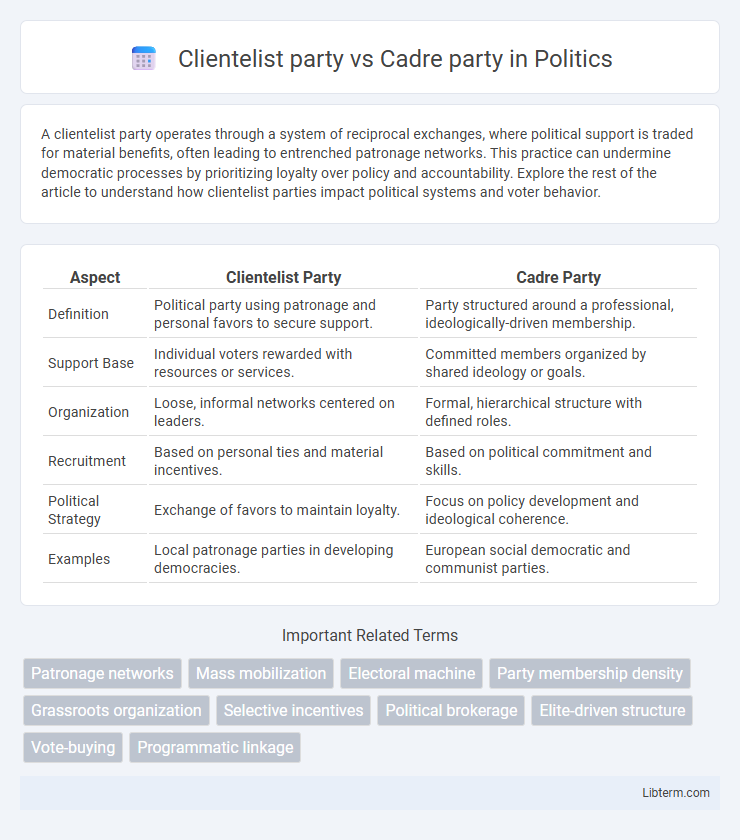A clientelist party operates through a system of reciprocal exchanges, where political support is traded for material benefits, often leading to entrenched patronage networks. This practice can undermine democratic processes by prioritizing loyalty over policy and accountability. Explore the rest of the article to understand how clientelist parties impact political systems and voter behavior.
Table of Comparison
| Aspect | Clientelist Party | Cadre Party |
|---|---|---|
| Definition | Political party using patronage and personal favors to secure support. | Party structured around a professional, ideologically-driven membership. |
| Support Base | Individual voters rewarded with resources or services. | Committed members organized by shared ideology or goals. |
| Organization | Loose, informal networks centered on leaders. | Formal, hierarchical structure with defined roles. |
| Recruitment | Based on personal ties and material incentives. | Based on political commitment and skills. |
| Political Strategy | Exchange of favors to maintain loyalty. | Focus on policy development and ideological coherence. |
| Examples | Local patronage parties in developing democracies. | European social democratic and communist parties. |
Defining Clientelist Parties: Key Characteristics
Clientelist parties primarily operate through networks of patronage and reciprocal exchanges between party leaders and voters, often trading material benefits for political support. These parties rely heavily on personalized relationships and local brokers who mobilize votes by distributing resources, rather than ideological appeal or programmatic platforms. This form of organization contrasts with cadre parties, which emphasize formal membership, bureaucratic structures, and policy-driven agendas.
Understanding Cadre Parties: Core Features
Cadre parties are characterized by a small, elite leadership group that prioritizes organizational efficiency and ideological cohesion over mass mobilization. These parties emphasize internal discipline, professional political management, and a focus on long-term governance strategies rather than immediate electoral gains. Unlike clientelist parties that rely on patronage networks, cadre parties maintain structured hierarchies and prioritize policy formulation and administrative expertise.
Historical Origins and Evolution
Clientelist parties originated in the late 19th and early 20th centuries, rooted in patron-client relationships where politicians provided material benefits in exchange for political support, common in developing democracies and emerging states. Cadre parties emerged earlier, typically in 19th-century Europe, structured around a politically active elite or "cadre" that shaped party organization and policy, often prioritizing ideological coherence over mass appeal. Over time, clientelist parties evolved by institutionalizing patronage networks, while cadre parties developed formal organizational hierarchies and broader membership bases, reflecting shifts in political modernization and democratization processes.
Organizational Structure and Membership
Clientelist parties exhibit a decentralized organizational structure centered around personal networks and patronage ties, where membership is often informal and contingent on access to resources or favors. Cadre parties maintain a formal, hierarchical organization with professionalized leadership and clearly defined roles, emphasizing ideological commitment among a selective, active membership. This structural difference influences party cohesion, operational efficiency, and the mechanisms through which political support is mobilized and sustained.
Methods of Voter Mobilization
Clientelist parties mobilize voters primarily through exchanging material benefits, favors, or services for political support, creating direct personal ties between politicians and constituents. Cadre parties utilize organizational structures, party loyalty, and ideological commitment, focusing on activating dedicated activists and members to generate voter turnout. This contrast highlights clientelist reliance on individualized incentives and cadre parties' emphasis on institutionalized party networks for electoral mobilization.
Role of Political Leaders and Elite Influence
Clientelist parties rely heavily on political leaders who act as brokers, distributing resources and favors to secure loyal voter bases, thereby reinforcing elite networks through personal patronage. In contrast, cadre parties emphasize ideological training and organizational discipline, where political leaders function more as administrators or policy experts rather than patronage brokers, limiting elite influence to formal party mechanisms. The leader's role in clientelist parties is inherently personalized and transactional, whereas cadre parties promote collective leadership and institutionalized elite control.
Policy Formation and Responsiveness
Clientelist parties prioritize policy formation that secures immediate material benefits for specific voter groups, often resulting in targeted patronage programs, while their responsiveness centers on delivering tangible goods to maintain electoral support. Cadre parties emphasize ideologically driven policy formation developed by a core leadership or expert group, fostering consistent programmatic platforms and long-term strategic goals. Their responsiveness is oriented towards mobilizing committed members and addressing collective interests over narrow personal gains.
Electoral Strategies and Campaign Tactics
Clientelist parties rely heavily on vote-buying, patronage networks, and direct material incentives to secure loyalty from voters during election campaigns. Cadre parties emphasize organizational discipline, ideological coherence, and mobilization of committed party members through structured grassroots networks and policy-focused outreach. Electoral strategies in clientelist parties prioritize short-term transactional exchanges, while cadre parties invest in long-term voter engagement and party institutionalization.
Impact on Democratic Governance
Clientelist parties undermine democratic governance by fostering patronage networks that prioritize personal loyalty over policy platforms, leading to weakened institutions and reduced accountability. Cadre parties enhance democratic governance through structured organizational frameworks and ideological coherence, promoting policy consistency and institutional stability. The contrast influences electoral competitiveness, citizen engagement, and the quality of representation within democratic systems.
Comparative Analysis: Clientelist vs Cadre Party Models
Clientelist parties rely on personalized exchanges and patronage networks, emphasizing direct material benefits to secure voter loyalty, whereas cadre parties prioritize ideological commitment and organizational discipline through a stable, institutionalized membership base. Clientelist parties often exhibit fluid loyalty and weaker party structures, while cadre parties maintain strong party cohesion and policy consistency rooted in bureaucratic frameworks. The effectiveness of clientelist models thrives in contexts with fragmented political landscapes, contrasting with cadre parties' suitability in systems favoring institutionalized political engagement and programmatic competition.
Clientelist party Infographic

 libterm.com
libterm.com